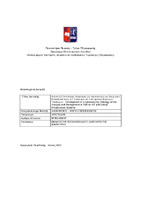Ανάπτυξη οντολογίας ασφάλειας για την ανάλυση και διαχείριση επικινδυνότητας ΙοΤ συσκευών και συστημάτων κρίσιμων υποδομών
Development of a cybersecurity ontology for the analysis and management or risk for IoT and critical infrastructure systems

Master Thesis
Συγγραφέας
Μπερζοβίτης, Αδαμάντιος - Μάριος
Berzovitis, Adamantios - Marios
Ημερομηνία
2022-06Προβολή/
Λέξεις κλειδιά
Cybersecurity ; Neo4j ; Python ; IoT ; OntologyΠερίληψη
Οι σύγχρονοι οργανισμοί και επιχειρήσεις, επεκτείνουν διαρκώς τα πληροφοριακά τους συστήματα τόσο σε ψηφιακό όσο και σε φυσικό επίπεδο. Παρατηρούνται μάλιστα, αλλεπάλληλες προσθήκες σε εξοπλισμό, που εκτείνονται από καθημερινούς σταθμούς εργασίας και δικτυακό εξοπλισμό έως Internet of Things (IOT) συσκευές και Supervisory Control and Data Acquisition (SCADA) συστήματα, σύμφωνα πάντα με τις ανάγκες των οργανισμών και επιχειρήσεων. Από τη σκοπιά της κυβερνοασφάλειας, οι διαρκείς αυτές αλλαγές, οξύνουν την ανάγκη στοιχειοθέτησης του μεγάλου και πολύπλοκου όγκου πληροφορίας, καθώς και την αποδοτική ανάλυση της, για την εξαγωγή των κατάλληλων συμπερασμάτων. Ο στόχος της εργασίας αυτής, είναι η ανάπτυξη μιας μεθοδολογίας που θα συμβάλει σε αυτήν την κατεύθυνση, με την υποβοήθηση ενός εργαλείου ανοιχτού κώδικα που υποστηρίζει την αναπαράσταση δημόσιων καταλόγων και βάσεων δεδομένων αδυναμιών όπως: Common Vulnerabilities and Exposures (CVE), Common Platform Enumeration (CPE) τα οποία καταγράφονται και ανανεώνονται από το National Institute of Technology (NIST) και οι κατάλογοι Common Weakness Enumeration (CWE) και Common Attack Pattern Enumeration and Classification (CAPEC) που παρέχονται από το MITRE, σε μορφή διασυνδεδεμένου γράφου. Στόχος αυτής της υλοποίησης αποτελεί η στήριξη υπαρχόντων μεθοδολογιών ανάλυσης και διαχείρισης επικινδυνότητας, μέσω της παροχής ενός εκτεταμένου χάρτη πληροφορίας που μπορεί να παρέχει αυτοματοποίηση στις φάσεις της αναγνώρισης απειλών και αδυναμιών ασφαλείας σε ένα πληροφοριακό σύστημα. Παράλληλα, παρουσιάζονται μελέτες περίπτωσης για την εξαγωγή πολύπλοκης πληροφορίας, σχετικά με υπάρχοντα προφίλ κακόβουλων χρηστών που παρέχει η βιβλιοθήκη Threat Agent Library της Intel.


